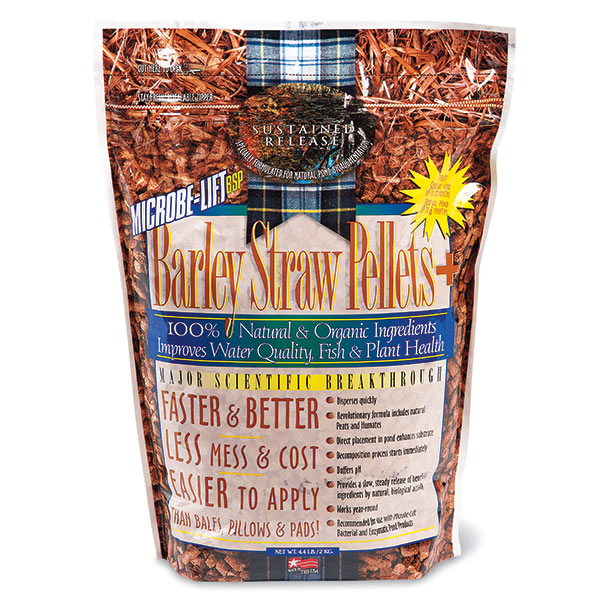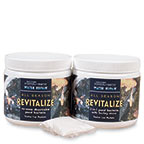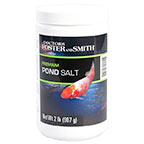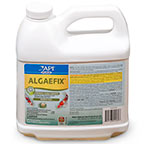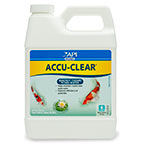Overview
| * | Concentrated barley straw pellets enriched with peat and humic acid for ponds |
| * | Improves water quality and clarifies ponds organically without harmful chemicals |
| * | Conditions pond water all year for a cost effective alternative to bales of pond barley |
Barley straw pellets are easier to apply to your pond than bales, pillows or pads. Decomposes quickly and works year-round to soften pond water and reduce negative effects of phosphate. Improves fish environment and works year-round. May also buffer pH and control some alkalinity, depending on level and length of use. 4.4 lbs. bag treats a 500 gallon pond up to 12 months or an 800 gallon pond up to 8 months.
Application Rates
Apply every six weeks. You may start your application any time of the year.
| Size of Pond | Clear Water | Turbid Water | ||
| Gallons | oz | ml | oz | ml |
| 80 | 2 | 70 | 5 | 140 |
| 100 | 3 | 90 | 6 | 180 |
| 150 | 4 | 130 | 9 | 260 |
| 200 | 6 | 175 | 12 | 350 |
| 300 | 9 | 260 | 18 | 520 |
| 400 | 12 | 350 | 24 | 700 |
| 500 | 15 | 425 | 30 | 850 |
| 600 | 18 | 525 | 35 | 1,000 |
| 700 | 21 | 600 | 40 | 1,200 |
| 800 | 24 | 700 | 48 | 1,400 |
| 1,000 | 30 | 870 | 60 | 1,750 |
- As the first application biodegrades and releases the active humic acids, the second application becomes ready to treat the pond and keep the natural biological cycle functional. A Fall treatment will save you problems in the spring.
- Be patient - natural processes take time. Initially the water may become cloudy or "tea" colored but will clear shortly.
- Barley Straw Pellets+ is the most convenient form of barley available today. It should be introduced preferably where water is flowing and the depth is less than three feet. You may also place some in your filter media box.
- This product is not a chemical. It is harmless to humans, animals, fish and plants. Since the manufacturer cannot control the pre-existing dynamics of your individual pond, the manufacturer is not responsible for loss or injury to animate materials in your pond or aquarium. The above information and instructions are subject to many variables. Many situations may be unique in nature.
General Information
Microbe-Lift Barley Straw+ is environmentally-responsible and cost-effective pond conditioner. It is a natural and organic way to a healthier pond environment. Barley straw and selected natural peat have been processed and packaged to make them easy to apply with no mess. Barley Straw Pellets+ is manufactured using an exclusive proprietary process that eliminates the use of wheat, corn or other binders. The barley straw is harvested and stored under climatic conditions that assure quality of essential ingredients. The process also makes these pellets weed free.
Barley Straw Pellets+ is rich in humic acids, which are very beneficial to the aquatic environment. Humic acid softens pond water, reduces the negative effect of phosphate and generally improves the environment for your fish. The humic acid will also chelate metals such as mercury or arsenic. In addition, oxygen and sunlight activates humic acids to produce hydrogen peroxide naturally and at a low level of release.
Barley Straw Pellets+ is completely harmless to fish and higher pond plants. The natural biological activity of fungus and bacteria breakdown barley straw to produce humic acids. Therefore, it can be used over a long period of time. The peat has already been broken down in ponds thousands of years ago. The peat becomes part of the substrate of your pond. Depending on level and length of use, the peat will buffer the pH and control some alkalinity. Some of the clearest pond waters stand over peat bottoms.
The Use of Humic Acid in Ponds
There is a chemical control, the exact mechanism of which is poorly understood, but is the subject of much research. What is known is that as the straw rots, it releases compounds called lignins into the water. These lignins are very persistent. If enough oxygen and sunlight are present, they will be converted into humic acids. These then break down, again in the presence of highly dissolved oxygen and sunlight, to release hydrogen peroxide.
If these specific humic acids are constantly present, there's a constant source of transient hydrogen peroxide. Consequently, if there's always a slow decomposition of straw, then there's always a source of the required humic acids. This would explain why the beneficial effects of barley bales take a period of time to show visible effects. These natural chemicals do not affect the growth of higher plants. The plants actually benefit due to reduced competition for light and nutrients. Reduce the phosphorous in the pond water and your pond should become clean and clear.
The Use of Peat in Ponds
Pond bottom soils tie-up phosphorous but significantly less than highly organic peat. A pond without soil in contact with pond water - such as one built with a liner - holds no phosphorous. Even with a liner, you end up with some substrate on the liner and having peat as a component of the substrate is beneficial. Higher plants with a root structure can utilize the phosphorous from the substrate. Phosphorous can enter our ponds from the source water, rain, run-off and fish food. It would behoove the pond keeper who seeks crystal clear pond water to be conscious of what is put into the pond and the usefulness of peat to reduce green pond water. Water stored over peat is best.



